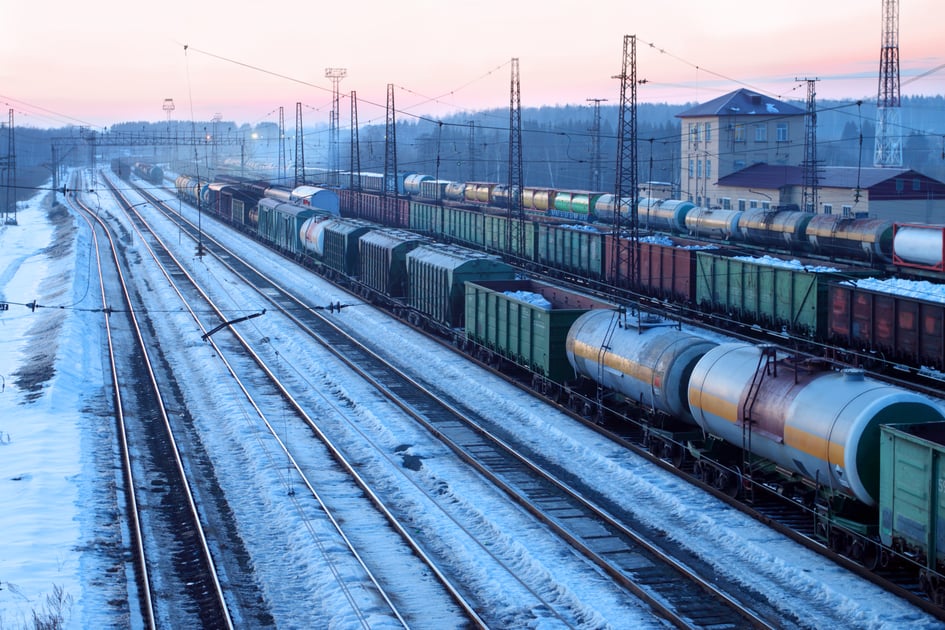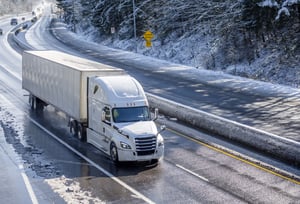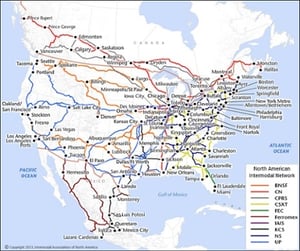
 We are constantly being bombarded by articles telling us trucking capacity is tight or will soon be tight and they go on to give numerous reasons why it is the case this time around. These constant hits have jaded many of us to a point that they are considered marketing material used by the freight community to justify higher prices, but for others it causes them to look for alternatives for their 53’ freight capacity requirements.
We are constantly being bombarded by articles telling us trucking capacity is tight or will soon be tight and they go on to give numerous reasons why it is the case this time around. These constant hits have jaded many of us to a point that they are considered marketing material used by the freight community to justify higher prices, but for others it causes them to look for alternatives for their 53’ freight capacity requirements.
Diversity in covering truckload capacity is applauded. Freight and financial success come through diversification, whether that is diversification of logistics and supply chain strategies or stocks, but after thousands of intermodal shipment experience in our operations thought is made sense to share some of what we have learned about intermodal that others can learn from and apply in their freight strategy.
One of the best opportunities to diversify 53’ freight capacity, outside of the standard thought of more truckload carrier and broker relationships, is to look for freight that works well for domestic intermodal.
Two recent examples where diversity across truckload and intermodal include the pandemic of 2020-2021 and the incredible freight run in 2018. Shippers that planned ahead did well in holding freight costs in check, while providing additional freight capacity which leads us to our topic on intermodal and how colder weather impacts the freight mode.
Intermodal and its operational characteristics bring challenges shippers need to be aware of because of their uniqueness to the freight mode that is not found in the more familiar 53’ truckload operations.
Unique Characteristics to Intermodal not Found in Truckload
 The four unique operational characteristics of intermodal that are not found in truckload include:
The four unique operational characteristics of intermodal that are not found in truckload include:
- Intermodal rail ramps are landlocked.
- Cold weather impacts the seals used on the air hose couplings used to build out the intermodal train.
- Once the intermodal container is loaded onto a train, it cannot be taken off the train until it grounds at its destination ramp.
- Three different freight companies touch the freight: origin dray, class I railroad and destination dray.
With the above in mind, let’s walk through how this impacts intermodal shipping.
Unlike truckload, where a driver can change their route because of congestion based on the Waze, Google Maps, etc. or similar navigation apps, intermodal does not have the option to divert to another ramp because of congestion. The reasons are intermodal routings are rigid and specific to meet up with other trains in its journey to most efficiently move from its origin to final destination.
On the landlocked front, winter weather challenges the intermodal ramps operations and capacities further when the unique operating characteristics are considered:
 In heavy snow years, with little melting like we saw in the 2013 - 2014 polar vortex, eventually there is not a place to put the snow so the intermodal ramp is forced to shut down a portion of the ramp so to keep operating.
In heavy snow years, with little melting like we saw in the 2013 - 2014 polar vortex, eventually there is not a place to put the snow so the intermodal ramp is forced to shut down a portion of the ramp so to keep operating.- For safety reasons, trains cannot be built to the same volume level during the winter months as can be done during the warmer weather months. The reason being is the air hose couplings between each intermodal well-car have rubber seals. These seals shrink in the cold and the colder the weather the more the rubber gaskets shrink. The result is air leaks out of the train’s braking system, which causes the operation to reduce the train length to compensate for the air loss.
- This condition shortens a specific train that is operating intermodal shipments, but to add to it when the ramp operations needs the most capacity on each train to turn and clear the equipment quickly the recovery process is slowed because the intermodal trains are shorter, not longer, than is required to help the congested intermodal ramp.
With the above in mind, winter does bring additional challenges to intermodal that shippers need to be aware of when they decide to use the freight mode for their shipments, whether operating at record volumes and excessive congestion or not. This holds true even if all is smooth in the truckload market.
With the summary behind us, let’s take a look at some of the specifics.
 Intermodal ramps will either close to be proactive for weather events or they could announce embargos if ramps get impacted too badly with weather conditions.
Intermodal ramps will either close to be proactive for weather events or they could announce embargos if ramps get impacted too badly with weather conditions.- Trucking issues with cold weather are not specific to over-the-road (OTR) moves. These situations can impact drayage for intermodal (IMDL) moves as well. The positive side of being proactive is if you are in close proximity to an intermodal ramp it is easier and quicker to recover with the short dray when conditions are bad than to recover with long OTR moves that experience the following issues:
- Frozen lines
- Trucks not starting
- Road Closures
- Bad Order Equipment issues tend to surface much more in snowing and icy weather, as well. As snow falls and creates pressure on the units, older and weaker parts on the containers/trailers begin to break down much quicker as snow collects and melts on the exposed to the elements every day.
To summarize, the things to be cautious during the winter months that are not present in the warmer months of the year are:
- Longer lead times for load requests.
- Higher spot pricing out of constrained markets.
- Longer transits, delivery delays, and potential unexpected costs related to storage and per diem.
Conclusion on Cold Weather's Impact on Intermodal
 As was mentioned earlier in this article and across several articles within our Learning Center intermodal is a great 53’ capacity option for shippers, so please do not take this as a negative article for a reason not to use intermodal within your logistics and supply chain strategy.
As was mentioned earlier in this article and across several articles within our Learning Center intermodal is a great 53’ capacity option for shippers, so please do not take this as a negative article for a reason not to use intermodal within your logistics and supply chain strategy.
Instead, use this article to apply best practices to be successful with intermodal when others continue to struggle.
In InTek’s situation, roughly 90% of our freight capacity operation is intermodal based so we have been able to turn the uniqueness to the advantage for shippers.
For more on intermodal, please refer to the top 5 most popular articles that have been read by our customers today to get them into the intermodal market successfully.
- The Complete Guide to Intermodal Transportation
-
Intermodal Marketing Company (IMC) - Definition, Purpose & Value)
-
11 Differences Between Intermodal and Truckload Every Shipper Should Know
If you're ready to take the next step, at InTek Freight & Logistics, we can help. Just tell us what you need and we'll discuss how our expertise can help with the unique shipping challenges your business faces. Rather do a bit more research first? View our Freight Guides for comprehensive articles and eBooks on all things freight and logistics.
Another great resource to find out more about the intermodal market, visit the Intermodal Association of North America website. IANA is North America's leading industry trade association representing the combined interests of the intermodal freight industry. Also, for more on the topic Intermodal Marketing Companies (IMC's) for Beginners is a quick read for more information on the topic.
Get Updates
Featured Articles
Categories
- Freight & Shipping Costs (53)
- Freight Broker (58)
- Freight Forwarder (2)
- Intermodal Transportation (181)
- International & Cross Border Logistics (43)
- Logistics & Supply Chain (414)
- Logistics Service Provider (76)
- LTL (39)
- Managed TMS (49)
- News (38)
- Supply Chain Sustainability (12)
- Transportation Management System (37)
- Truckload (121)
- Warehousing & Distribution (49)




